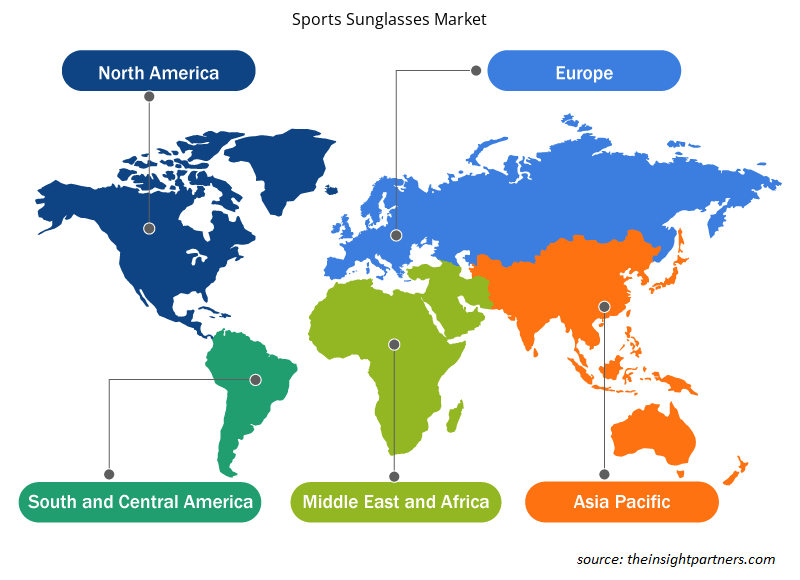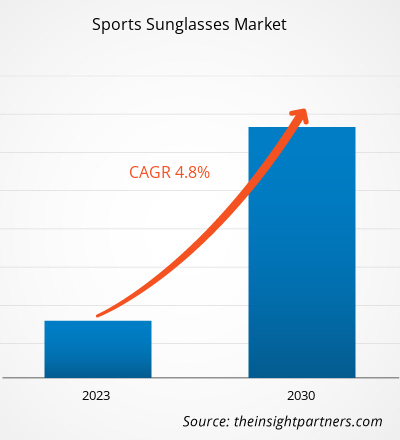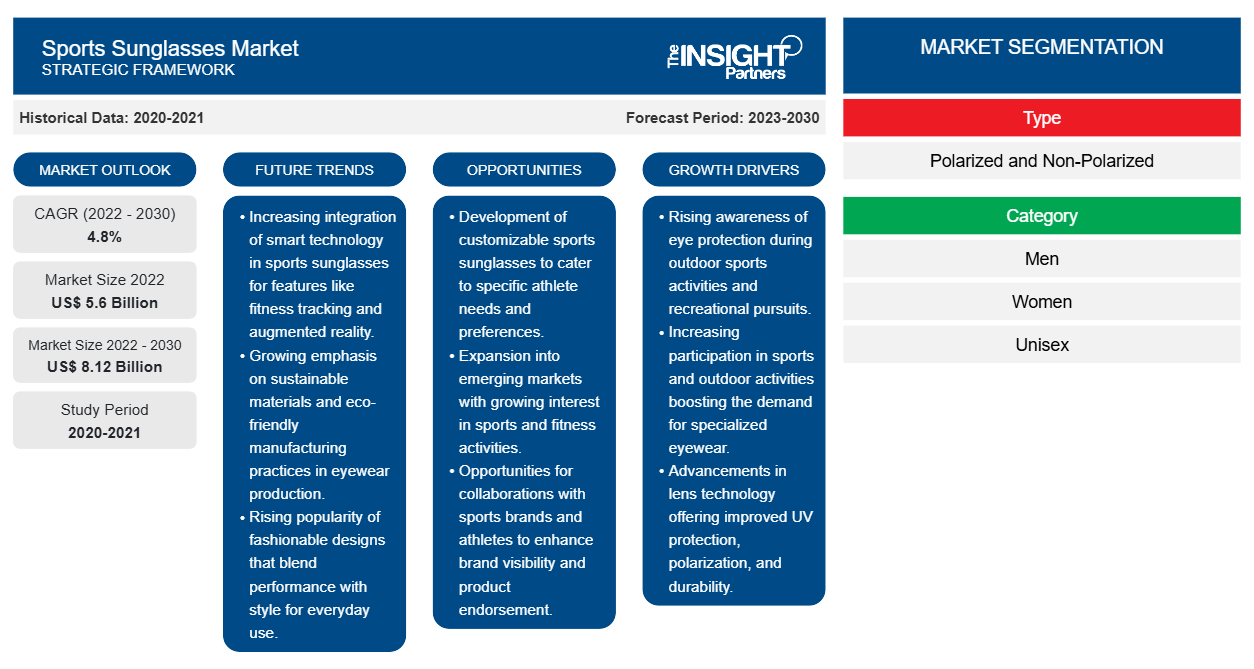[تقرير بحثي] من المتوقع أن ينمو حجم سوق النظارات الشمسية الرياضية من 5،597.08 مليون دولار أمريكي في عام 2022 إلى 8،115.06 مليون دولار أمريكي بحلول عام 2030؛ ومن المتوقع أن يسجل السوق معدل نمو سنوي مركب بنسبة 4.8٪ من عام 2022 إلى عام 2030.
رؤى السوق ووجهة نظر المحلل:
النظارات الشمسية الرياضية هي نظارات واقية تستخدم لتحسين الرؤية والراحة أثناء ممارسة الرياضات الخارجية. فهي تقلل من التعرض لأشعة الشمس القاسية لمنع أي ضرر للعينين. يتم تصنيع العدسات باستخدام مواد بلاستيكية أو زجاجية. وهي مطلية بحاجبات للأشعة فوق البنفسجية وأفلام مقاومة للصدمات تقلل من الوهج وتحسن التباين لتوفير رؤية أفضل في الميدان. تتوفر النظارات الشمسية أيضًا في أنواع مستقطبة أو غير مستقطبة مع عدسات ملونة وغير ملونة، مما يجعلها مناسبة للارتداء اليومي. تُستخدم النظارات الشمسية الرياضية عمومًا أثناء ممارسة الأنشطة الرياضية مثل ركوب الدراجات والسباحة وركوب الدراجات الجبلية وركوب الدراجات والبيسبول والكريكيت وغيرها من الأنشطة الخارجية. هذه العوامل تدفع سوق النظارات الشمسية الرياضية
محركات النمو والتحديات:
يمارس العديد من الأشخاص مختلف أنواع الرياضات والأنشطة الخارجية. ويدرك عشاق الرياضة أهمية حماية أعينهم من المخاطر المحتملة مثل الغبار والرياح والحطام. وبالتالي، يستخدمون نظارات شمسية رياضية مصممة لتوفير الحماية المثلى وتعزيز الأداء أثناء الأنشطة الرياضية. ووفقًا لجمعية صناعة الرياضة واللياقة البدنية (SFIA)، شارك أكثر من 76% من السكان (أي 236.9 مليون شخص) في الولايات المتحدة في نشاط واحد على الأقل في عام 2022، بزيادة قدرها 9.2% في معدلات المشاركة الإجمالية عن عام 2017 وزيادة بنسبة 1.9% عن عام 2021. ووفقًا لـ Eurostat، في عام 2019، مارس حوالي 44% من سكان أوروبا بعض الأنشطة البدنية مرة واحدة على الأقل في الأسبوع. بالإضافة إلى ذلك، أدى التنوع في الرياضات والأنشطة الخارجية إلى خلق طلب على النظارات الشمسية الرياضية المصممة لتلبية احتياجات محددة.
علاوة على ذلك، أدى التحول الثقافي نحو نمط حياة أكثر صحة ونشاطًا إلى زيادة عدد الأشخاص الذين يمارسون الرياضة والأنشطة الخارجية. ولا يقتصر هذا التحول على الرياضيين التنافسيين، بل يشمل الأفراد المشاركين في الرياضات الترفيهية والجري والمشي لمسافات طويلة وغيرها من الأنشطة الترفيهية. أصبحت النظارات الشمسية الرياضية بمثابة بيان للأزياء ورمزًا لأسلوب الحياة النشط هذا.
يمكن أن يؤدي التعرض المطول للأشعة فوق البنفسجية (UV)، وخاصة في الأماكن الخارجية، إلى حالات وأمراض مختلفة في العين مثل إعتام عدسة العين والتهاب القرنية الضوئي والزوائد اللحمية. يمكن أن تؤدي هذه الحالات إلى عدم الراحة وضعف البصر وفي بعض الحالات تلف دائم للعين. عند المشاركة في الرياضة أو الأنشطة الخارجية الأخرى، يحتاج الأفراد إلى رؤية واضحة وغير معوقة لأداء أفضل ما لديهم. يمكن أن يؤدي التعرض المفرط للأشعة فوق البنفسجية إلى الحول وعدم الراحة وانخفاض وضوح الرؤية. تضمن النظارات الشمسية الرياضية المزودة بحماية من الأشعة فوق البنفسجية أن يتمكن الرياضيون من الحفاظ على الرؤية والتركيز الأمثل أثناء أنشطتهم، مما يعزز أدائهم العام.
قم بتخصيص هذا التقرير ليناسب متطلباتك
ستحصل على تخصيص لأي تقرير - مجانًا - بما في ذلك أجزاء من هذا التقرير، أو تحليل على مستوى الدولة، وحزمة بيانات Excel، بالإضافة إلى الاستفادة من العروض والخصومات الرائعة للشركات الناشئة والجامعات
-
احصل على أهم اتجاهات السوق الرئيسية لهذا التقرير.ستتضمن هذه العينة المجانية تحليلاً للبيانات، بدءًا من اتجاهات السوق وحتى التقديرات والتوقعات.
تقسيم التقرير ونطاقه:
"سوق النظارات الشمسية الرياضية العالمية" مقسمة على أساس النوع والفئة وقناة التوزيع والجغرافيا. بناءً على النوع، يتم تقسيم سوق النظارات الشمسية الرياضية إلى مستقطبة وغير مستقطبة. من حيث الفئة، يتم تقسيم السوق إلى الرجال والنساء والجنسين والأطفال. بناءً على قناة التوزيع، يتم تقسيم سوق النظارات الشمسية الرياضية إلى محلات السوبر ماركت والهايبر ماركت والمتاجر المتخصصة والتجزئة عبر الإنترنت وغيرها. من حيث الجغرافيا، يتم تقسيم السوق إلى أمريكا الشمالية (الولايات المتحدة وكندا والمكسيك) وأوروبا (ألمانيا وفرنسا وإيطاليا والمملكة المتحدة وروسيا وبقية أوروبا) وآسيا والمحيط الهادئ (أستراليا والصين واليابان والهند وكوريا الجنوبية وبقية آسيا والمحيط الهادئ) والشرق الأوسط وأفريقيا (جنوب أفريقيا والمملكة العربية السعودية والإمارات العربية المتحدة وبقية الشرق الأوسط وأفريقيا) وأمريكا الجنوبية والوسطى (البرازيل والأرجنتين وبقية أمريكا الجنوبية والوسطى)
التحليل القطاعي:
بناءً على النوع، يتم تقسيم سوق النظارات الشمسية الرياضية إلى مستقطبة وغير مستقطبة. احتلت الفئة غير المستقطبة حصة كبيرة من السوق في عام 2022. يتزايد الطلب على النظارات الشمسية الرياضية غير المستقطبة بين الرياضيين وعشاق اللياقة البدنية الذين يحتاجون إلى حماية أعينهم أثناء الأداء، إلى جانب ضمان الرفاهية العامة. أدت التطورات في تكنولوجيا العدسات إلى تقديم نظارات شمسية رياضية غير مستقطبة أكثر خفة الوزن وراحة ومتانة، مما يجذب جمهورًا أوسع. علاوة على ذلك، أدى تأثير صناعة الأزياء على إكسسوارات الرياضة إلى زيادة شعبية النظارات الشمسية الرياضية غير المستقطبة الأنيقة والعملية بين الأشخاص الذين يسعون إلى الأداء والجماليات في اختيارات النظارات الخاصة بهم.
التحليل الإقليمي:
بناءً على الجغرافيا، يتم تقسيم سوق النظارات الشمسية الرياضية إلى خمس مناطق رئيسية - أمريكا الشمالية وأوروبا وآسيا والمحيط الهادئ وأمريكا الجنوبية والوسطى والشرق الأوسط وأفريقيا. سيطرت أمريكا الشمالية على سوق النظارات الشمسية الرياضية العالمية. بلغت قيمة السوق الإقليمية 1791 مليون دولار أمريكي في عام 2022. تعد أوروبا ثاني أكبر مساهم في السوق، حيث تمتلك ما يقرب من 25٪ من السوق العالمية. من المتوقع أن يسجل الشرق الأوسط وأفريقيا معدل نمو سنوي مركب بنسبة 6.5٪ في سوق النظارات الشمسية الرياضية خلال فترة التوقعات. في أمريكا الشمالية، من المتوقع أن ينمو السوق بشكل كبير بسبب زيادة المشاركة في الرياضة وزيادة الوعي المتعلق بحماية العين. وفقًا لجمعية صناعة الرياضة واللياقة البدنية (SFIA)، شارك أكثر من 76٪ من جميع الأمريكيين، أو 236.9 مليون شخص، في نشاط رياضي واحد على الأقل خلال عام 2022. وبالتالي، فإن المشاركة المتزايدة لأمريكا الشمالية في فئات رياضية مختلفة تعمل على زيادة الطلب على النظارات الشمسية الرياضية في جميع أنحاء المنطقة. علاوة على ذلك، شهد السوق في الشرق الأوسط وأفريقيا نموًا بارزًا بسبب الاستثمارات الحكومية المكثفة في قطاع الرياضة. على سبيل المثال، أنفقت دول مجلس التعاون الخليجي، بما في ذلك المملكة العربية السعودية والإمارات العربية المتحدة، أكثر من 65 مليار دولار أمريكي على تطوير الرياضة في عام 2022، مع التركيز الأساسي على كرة القدم والرياضات الإلكترونية، والتي يُعتقد أنها تتمتع بأكبر قدر من الإمكانات لنمو الإيرادات. إن الوعي المتزايد بأهمية الرياضة واللياقة البدنية بين الأفراد وعشاق اللياقة البدنية يدفع الطلب على النظارات الشمسية الرياضية في الشرق الأوسط وأفريقيا.
تطورات الصناعة والفرص المستقبلية:
فيما يلي قائمة بالمبادرات المختلفة التي اتخذها اللاعبون الرئيسيون العاملون في سوق النظارات الشمسية الرياضية:
- في ديسمبر 2022، تعاونت SunGod، وهي علامة تجارية بريطانية للنظارات، مع فريق دراجات هوائية مقره لندن لإطلاق نظارات شمسية Tekkerz Vulcanz. يتضمن الطراز عدسة ضوئية متدرجة اللون وإطارًا من البوليمر الذاكري للأشعة فوق البنفسجية وجوارب أذن ووسادات أنف محبة للماء.
رؤى إقليمية حول سوق النظارات الشمسية الرياضية
لقد قام المحللون في Insight Partners بشرح الاتجاهات والعوامل الإقليمية المؤثرة على سوق النظارات الشمسية الرياضية طوال فترة التوقعات بشكل شامل. يناقش هذا القسم أيضًا قطاعات سوق النظارات الشمسية الرياضية والجغرافيا في جميع أنحاء أمريكا الشمالية وأوروبا ومنطقة آسيا والمحيط الهادئ والشرق الأوسط وأفريقيا وأمريكا الجنوبية والوسطى.

- احصل على البيانات الإقليمية المحددة لسوق النظارات الشمسية الرياضية
نطاق تقرير سوق النظارات الشمسية الرياضية
| سمة التقرير | تفاصيل |
|---|---|
| حجم السوق في عام 2022 | 5.6 مليار دولار أمريكي |
| حجم السوق بحلول عام 2030 | 8.12 مليار دولار أمريكي |
| معدل النمو السنوي المركب العالمي (2022 - 2030) | 4.8% |
| البيانات التاريخية | 2020-2021 |
| فترة التنبؤ | 2023-2030 |
| القطاعات المغطاة |
حسب النوع
|
| المناطق والدول المغطاة |
أمريكا الشمالية
|
| قادة السوق وملفات تعريف الشركات الرئيسية |
|
كثافة اللاعبين في سوق النظارات الشمسية الرياضية: فهم تأثيرها على ديناميكيات الأعمال
يشهد سوق النظارات الشمسية الرياضية نموًا سريعًا، مدفوعًا بالطلب المتزايد من المستخدم النهائي بسبب عوامل مثل تفضيلات المستهلك المتطورة والتقدم التكنولوجي والوعي المتزايد بفوائد المنتج. ومع ارتفاع الطلب، تعمل الشركات على توسيع عروضها والابتكار لتلبية احتياجات المستهلكين والاستفادة من الاتجاهات الناشئة، مما يؤدي إلى زيادة نمو السوق.
تشير كثافة اللاعبين في السوق إلى توزيع الشركات أو المؤسسات العاملة في سوق أو صناعة معينة. وهي تشير إلى عدد المنافسين (اللاعبين في السوق) الموجودين في مساحة سوق معينة نسبة إلى حجمها أو قيمتها السوقية الإجمالية.
الشركات الرئيسية العاملة في سوق النظارات الشمسية الرياضية هي:
- العشاري
- شركة أديداس ايه جي
- مجموعة لوكسوتيكا
- ليبرتي سبورت
- شركة نايكي
إخلاء المسؤولية : الشركات المذكورة أعلاه ليست مرتبة بأي ترتيب معين.

- احصل على نظرة عامة على أهم اللاعبين الرئيسيين في سوق النظارات الشمسية الرياضية
تأثير جائحة كوفيد-19:
أثرت جائحة كوفيد-19 سلبًا على جميع الصناعات تقريبًا في مختلف البلدان. أعاقت عمليات الإغلاق والقيود المفروضة على السفر وإغلاق الشركات في أمريكا الشمالية وأوروبا ومنطقة آسيا والمحيط الهادئ وأمريكا الجنوبية والوسطى والشرق الأوسط وأفريقيا نمو العديد من الصناعات، بما في ذلك صناعة السلع الاستهلاكية. أدى إغلاق وحدات التصنيع إلى اضطراب سلاسل التوريد العالمية وأنشطة التصنيع وجداول التسليم ومبيعات المنتجات الأساسية وغير الأساسية. أفادت العديد من الشركات عن تأخيرات في تسليم المنتجات وانخفاض في مبيعات منتجاتها في عام 2020. أيضًا، في الفترة المبكرة من الأزمة، كان المصنعون يعتمدون بشكل كبير على المخزون الحالي. وبسبب الركود الاقتصادي الناجم عن الوباء، أصبح المستهلكون أكثر حذرًا وانتقائية في قرارات الشراء. لقد حدوا بشكل كبير من المشتريات غير الأساسية بسبب انخفاض الدخول وآفاق الكسب غير المؤكدة، وخاصة في المناطق النامية.
بحلول نهاية عام 2021، تم تطعيم العديد من البلدان بالكامل، وأعلنت الحكومات عن تخفيف بعض القيود، بما في ذلك عمليات الإغلاق وحظر السفر. أثرت اتجاهات نمط الحياة المتغيرة بعد الوباء مثل التركيز المتزايد على الراحة والرفاهية والتخصيص على الطلب على النظارات الشمسية الرياضية. كما قدم نمو البيع بالتجزئة عبر الإنترنت أثناء الوباء فرصًا لمصنعي النظارات الشمسية الرياضية. إلى جانب ذلك، ساعد تخفيف القيود التجارية في عمليات الاستيراد والتصدير، مما أثر بشكل إيجابي على نمو سوق النظارات الشمسية الرياضية.
المنافسة والشركات الرئيسية:
تعد شركة Columbia Sportswear Co، وEssilorLuxottica SA، وLiberty Sport Inc، وUnder Armour Inc، وNike Inc، وRapha Racing Ltd، وPuma SE، وDecathlon SE، وAdidas AG، وSafilo Group SpA من بين اللاعبين البارزين الذين يعملون في سوق النظارات الشمسية الرياضية العالمية. تتبنى هذه الشركات مبادرات التطوير الاستراتيجي للتوسع، مما يؤدي إلى زيادة نمو السوق.
- التحليل التاريخي (سنتان)، سنة الأساس، التوقعات (7 سنوات) مع معدل النمو السنوي المركب
- تحليل PEST و SWOT
- حجم السوق والقيمة / الحجم - عالمي، إقليمي، بلد
- الصناعة والمنافسة
- مجموعة بيانات إكسل
التقارير الحديثة
شهادات العملاء
سبب الشراء
- اتخاذ قرارات مدروسة
- فهم ديناميكيات السوق
- تحليل المنافسة
- رؤى العملاء
- توقعات السوق
- تخفيف المخاطر
- التخطيط الاستراتيجي
- مبررات الاستثمار
- تحديد الأسواق الناشئة
- تحسين استراتيجيات التسويق
- تعزيز الكفاءة التشغيلية
- مواكبة التوجهات التنظيمية























 احصل على عينة مجانية ل - سوق النظارات الشمسية الرياضية
احصل على عينة مجانية ل - سوق النظارات الشمسية الرياضية